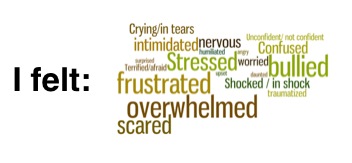This week’s guest blogger is Professor Noel Semple, our colleague at the Faculty of Law University of Windsor and a member of the NSRLP Advisory Board. Noel is working with the original study database to probe the psychological and other social costs of self-representation, and this piece describes some of those impacts on SRLs.
Tackling your own legal problem without a lawyer may save money – that’s usually why people do it. But that doesn’t mean that self-representation is cost-free. Going it alone imposes a variety of costs both on self-represented litigants themselves and on others. This month, the National Self-Represented Litigants Project (NSRLP) is focused on the complex costs and impacts of self-representation, which often extend beyond the individual litigant.
The NSRLP’s database of SRL interviews is a powerful source of information about the costs of seeking civil justice. For example, it includes multiple reports of lost employment income resulting from the time-consuming obligations of litigation.
The database also includes a trove of data about what are known as the psychological costs of seeking civil justice.[1] Psychological costs can be understood as the negative feelings or sentiments created by an experience or process. The 2013 SRL Research Report highlights some of the more common psychological costs of the self-representation experience, including the sense of social isolation and failing faith in the justice system that many experience.
In order to learn more about these psychological costs, I reviewed 235 interview transcripts from the NSRLP database. Most of the litigants who were interviewed indicated how the experience of seeking civil justice – or some constituent part of that experience — made them feel. Within these 235 transcripts, I flagged 664 such “sentiment reports.”
Of the 664 sentiment reports, 79.6% (529 records) were negative. In other words, there were roughly 4 negative sentiments reported by the interviewees for each positive one. The following word cloud shows all of the negative sentiments that were reported five times or more. The size of each word is proportional to the number of times it appeared in the database.
That SRLs used such words to describe their experience will not surprise anyone who has been following the NSRLP’s research. However one thing that struck me was that negative sentiments about the (e.g. feeling frustrated or overwhelmed by it) significantly outnumbered negative sentiments about the respondents’ in litigation (e.g. feeling bullied by them).
That SRLs used such words to describe their experience will not surprise anyone who has been following the NSRLP’s research. “However one thing that struck me was that negative sentiments about the process (e.g. feeling frustrated or overwhelmed by it) significantly outnumbered negative sentiments about the respondents’ adversaries in litigation (e.g. feeling bullied by them).’
On the bright side
Slightly more than 20% of the sentiment reports (135 in total) were positive. The two most common positive adjectives used to describe the feeling of being involved in civil litigation were “confident” (27 instances in the transcripts) and “capable” (10 instances).
Many of the sentiment reports coded positive were feelings of resolution or refusal to surrender. For example five respondents described themselves as feeling “determined” and others said they felt “compelled to bring the issue” or something similar.
Where is civil justice costliest? Family vs. other civil courts
The NSRLP interviewed litigants in family courts, small claims courts, and other civil courts. There is some tentative evidence that the balance of negative and positive sentiments differs depending on the court. 33% of the 49 sentiment reports from small claims court experiences were positive, compared to only 17% of those from family court.[2]
Further analysis will be necessary to determine whether these findings are statistically significant. However, the data may suggest that family litigation creates greater emotional costs for litigants than non-family civil litigation does.
What is abundantly clear from the NSRLP’s data is that seeking civil justice often imposes significant psychological costs on litigants, in addition to the more familiar time and money costs.
[1] David M. Trubek et al., “The Costs of Ordinary Litigation” (1983) 31 University of California at Los Angeles Law Review 72; The Cost of Justice: Weighing the Costs of Fair and Effective Resolution to Legal Problems (Proposal Description Submitted as SSHRC Application) (2010) <http://cfcj-fcjc.org/docs/2010/cost-cura-proposal-en.pdf> (last accessed: 3 June 2014).
[2] Sentiment reports from other civil court experiences were 23% positive.













I know people who actually lost their freedom- judge sent them to prison. Who wants to know about this?